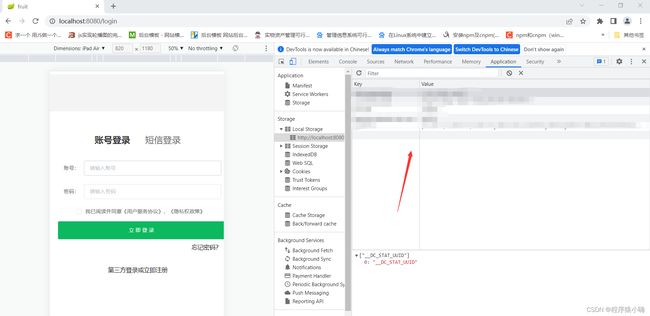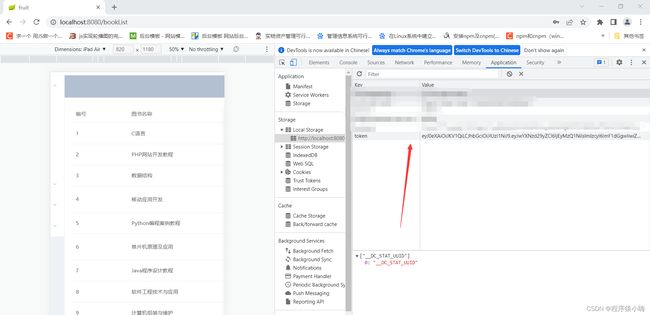SpringBoot+Vue整合Token(自我学习记录)
SpringBoot+Vue整合Token
Token
- Token其实就是客户端访问资源的通关令牌,当客户端拥有这个Token,就可以无阻碍的访问资源,适用于前后分离的项目,这里使用Springboot+Vue来整合Token。
- Token的验证机制过程:
①当客户端输入账号和密码时,通过请求接口将账号密码传回服务器端
②服务器端对客户端传回来的账号密码进行验证,验证通过后,根据制定好的机制(这里使用JWT)生成一个独一无二的Token(具有时效性)
③将服务器端生成的Token返回客户端,让客户端存储Token
④之后当客户端每次向服务器端发起请求的时候,必须携带Token保存在请求header中
⑤服务器端根据客户端传递过来的Token解析验证用户信息,若Token不正确或已过期,则返回错误信息,若验证通过,则返回相应的请求结果 - 注意:客户端的每次成功登录都会产生一个Token,Token具有时效性,只要在时效内每个Token都可以使用,可以想办法得到一个用户只有一个Token的效果,每次登录产生一个Token后,之前的Token即使没有过期也不能使用。
SpringBoot
- 引入依赖(在pom.xml中)
这里使用JWT来生成Token
<dependency>
<groupId>com.auth0groupId>
<artifactId>java-jwtartifactId>
<version>3.9.0version>
dependency>
<dependency>
<groupId>org.jsongroupId>
<artifactId>jsonartifactId>
<version>20190722version>
dependency>
- 新增配置类(在config配置包中)
TokenInterceptor(Token拦截器)
@Component
public class TokenInterceptor implements HandlerInterceptor {
@Override
public boolean preHandle(HttpServletRequest request, HttpServletResponse response, Object handler) throws Exception {
//跨域请求会首先发一个option请求,直接返回正常状态并通过拦截器
if(request.getMethod().equals("OPTIONS")){
response.setStatus(HttpServletResponse.SC_OK);
return true;
}
response.setCharacterEncoding("utf-8");
//这里的"token",前端header传回来的token参数名字是什么这里就叫什么
String token = request.getHeader("token");
if (token!=null){
boolean result= TokenUtils.verify(token);
if (result){
System.out.println("通过拦截器");
return true;
}
}
response.setContentType("application/json; charset=utf-8");
try {
JSONObject json=new JSONObject();
json.put("msg","token verify fail");
json.put("code","500");
response.getWriter().append(json.toString());
System.out.println("认证失败,未通过拦截器");
} catch (Exception e) {
return false;
}
/**
* 还可以在此处检验用户存不存在等操作
*/
return false;
}
}
WebConfiguration(配置拦截器)
@Configuration
public class WebConfiguration implements WebMvcConfigurer {
@Autowired
private TokenInterceptor tokenInterceptor;
/**
* 解决跨域请求
* @param registry
*/
@Override
public void addCorsMappings(CorsRegistry registry) {
registry.addMapping("/**")
.allowedHeaders("*")
.allowedMethods("*")
// .allowedOrigins("*")
.allowedOriginPatterns("*")
.allowCredentials(true);
}
/**
* 异步请求配置
* @param configurer
*/
@Override
public void configureAsyncSupport(AsyncSupportConfigurer configurer) {
configurer.setTaskExecutor(new ConcurrentTaskExecutor(Executors.newFixedThreadPool(3)));
configurer.setDefaultTimeout(30000);
}
/**
* 配置拦截器、拦截路径
* 每次请求到拦截的路径,就会去执行拦截器中的方法
* @param configurer
*/
@Override
public void addInterceptors(InterceptorRegistry registry) {
List<String> excludePath = new ArrayList<>();
//排除拦截,除了注册登录(此时还没token),其他都拦截
excludePath.add("/register"); //注册
excludePath.add("/login"); //登录
excludePath.add("/login1"); //token登录
excludePath.add("/selectUserList"); //用户列表
// excludePath.add("/getBookList"); //书本
excludePath.add("/doc.html"); //swagger
excludePath.add("/swagger-ui.html"); //swagger
excludePath.add("/swagger-resources/**"); //swagger
excludePath.add("/v2/api-docs"); //swagger
excludePath.add("/webjars/**"); //swagger
// excludePath.add("/static/**"); //静态资源
// excludePath.add("/assets/**"); //静态资源
registry.addInterceptor(tokenInterceptor)
.addPathPatterns("/**")
.excludePathPatterns(excludePath);
WebMvcConfigurer.super.addInterceptors(registry);
}
}
- 新增工具类(在utils工具包中)
TokenUtils(Token工具类,用于生成和效验Token)
public class TokenUtils {
//token到期时间 1000等于1秒
// private static final long EXPIRE_TIME= 10*60*60*1000;
private static final long EXPIRE_TIME= 30*1000;
//密钥盐
private static final String TOKEN_SECRET="litianpei**3nkjnj??";
/**
* 生成token
* @param user
* @return
*/
public static String sign(User user){
String token=null;
try {
Date expireAt=new Date(System.currentTimeMillis()+EXPIRE_TIME);
token = JWT.create()
//发行人
.withIssuer("auth0")
//存放数据
.withClaim("account",user.getAccount())
.withClaim("password",user.getPassword())
//过期时间
.withExpiresAt(expireAt)
.sign(Algorithm.HMAC256(TOKEN_SECRET));
} catch (IllegalArgumentException|JWTCreationException je) {
}
return token;
}
/**
* token验证
* @param token
* @return
*/
public static Boolean verify(String token){
try {
//创建token验证器
JWTVerifier jwtVerifier= JWT.require(Algorithm.HMAC256(TOKEN_SECRET)).withIssuer("auth0").build();
DecodedJWT decodedJWT=jwtVerifier.verify(token);
System.out.println("认证通过:");
System.out.println("account: " + decodedJWT.getClaim("account").asString());
System.out.println("过期时间: " + decodedJWT.getExpiresAt());
} catch (IllegalArgumentException |JWTVerificationException e) {
//抛出错误即为验证不通过
return false;
}
return true;
}
}
- 新增响应类和返回类
响应类 BaseResponse
@Data
public class BaseResponse<T> {
private String code;
private String message;
private T data;
/**
*
* 默认构造方法
*
* @param code
* 状态码
* @param message
* 接口信息
* @param data
* 接口数据
*/
public BaseResponse(String code, String message, T data) {
super();
this.code = code;
this.message = message;
this.data = data;
}
/**
* 默认构造方法
*/
public BaseResponse() {
super();
}
}
返回类
public class RespGenerator {
/**
* 接口调用成功时出参
*
* @param data
* 接口返回数据
* @return
*/
@SuppressWarnings({ "unchecked", "rawtypes" })
public static BaseResponse returnOK(Object data) {
return new BaseResponse("200", "接口调用成功!", data);
}
/**
* 调用失败
*
* @param code
* 错误码
* @param message
* 错误信息
* @return
*/
public static BaseResponse<Object> returnError(String code, String message) {
return new BaseResponse<Object>(code, message, null);
}
/**
* 调用失败
*
* @param message
* 错误信息
* @return
*/
public static BaseResponse<Object> returnError(String message) {
return new BaseResponse<Object>("-1", message, null);
}
}
- 改造登录接口
根据客户端传回来的账号密码进行验证,验证通过后使用Token工具类(TokenUtils)生成一个Token返回客户端。
@GetMapping("/login1")
@ApiOperation(value = "登录接口token", notes = "登录接口token")
@ApiImplicitParams({
@ApiImplicitParam(name = "account", value = "用户名", paramType = "String"),
@ApiImplicitParam(name = "password", value = "密码", paramType = "String"),
@ApiImplicitParam(name = "token", value = "token", paramType = "header")
})
public BaseResponse<HashMap> login(@RequestParam(value = "account") String account, @RequestParam(value = "password") String password){
User user = userService.selectUserByAccountAndPassword(account,password);
System.out.println("userList"+user);
if(user!=null){ //根据账号密码查询用户信息,如果账号密码不匹配,查询出来的用户信息就为null,若用户信息不为null,则设置user值
user.setAccount(account);
user.setPassword(password);
System.out.println(user.getAccount());
System.out.println(user.getPassword());
}
String token= TokenUtils.sign(user);
HashMap<String,Object> hs=new HashMap<>();
hs.put("token",token);
return RespGenerator.returnOK(hs);
}
- 改造查询书本信息接口
@GetMapping("/getBookList")
@ApiOperation(value = "查询所有书本信息", notes = "查询所有书本信息接口")
@ApiImplicitParams({
@ApiImplicitParam(name = "token", value = "token", paramType = "header")
})
public List<Book> getBookList(HttpServletRequest request){
String token = request.getHeader("token");
List<Book> bookList = bookService.getBookList();
System.out.println(token);
return bookList;
} return bookList;
}
Vue
- 安装Router
使用以下命令安装Router(可以在命令后面加版本号,安装的版本最好对应Vue的版本,以免版本太高会出错)
npm install vue-router
不懂安装流程可以直接上官网Vue Router
- 安装Vuex
使用以下命令安装Vuex(可以在命令后面加版本号,安装的版本最好对应Vue的版本,以免版本太高会出错)
npm install vuex@next --save
不懂安装流程可以直接上官网Vuex
- 安装axios
使用以下命令安装axios(可以在命令后面加版本号,安装的版本最好对应Vue的版本,以免版本太高会出错)
npm install axios
不懂安装流程可以直接上官网axios
- 在src文件夹中新建文件夹和文件
src/router/index.js
src/store/index.js
src/utils/request.js

- 在main.js添加配置
import router from './router'
import store from './store/index.js'
import axios from 'axios'
Vue.prototype.$axios = axios
import instance from './utils/request.js' //axios 封装
new Vue({
router,
store,
render: h => h(App),
}).$mount('#app')
- 配置router/index.js
添加路由前置守卫beforeEach拦截路由请求
router.beforeEach((to,from,next)=>{
if(to.path==='/login'||to.path==='/register'||to.path==='/'){
next()
}else{
let accountToken = localStorage.getItem('token');
console.log("token为:"+accountToken);
if(accountToken==null||accountToken==''){
alert("没有权限,请重新登录");
return next('/login');
}else{
next();
}
}
})
- 配置utils/request.js
添加请求拦截器,在请求头中加Token
axios.interceptors.request.use(
config=>{
if(localStorage.getItem('token')){
config.headers.token=localStorage.getItem('token');
}
return config;
},
error=>{
return Promise.reject(error);
}
)
- 配置store/index.js
const store = new Vuex.Store({
state:{
account:localStorage.getItem('account')?localStorage.getItem('account'):null,
token:localStorage.getItem('token')?localStorage.getItem('token'):null,
},
mutations:{
setAccount(state,account){
state.account=account
localStorage.setItem('account',JSON.stringify(account))
},
setToken(state,token){
localStorage.setItem('token',token)
state.token=token
},
logout(state){
localStorage.removeItem('token')
state.token=null
localStorage.removeItem('account')
state.account=null
}
},
})
- 修改登录方法
login(account, password) {
this.$axios.get('login', {
params: {
account: account,
password: password
}
}).then(res => {
if (res.data.code == 200) {
this.$store.commit('setToken', res.data.data.token)
this.$store.commit('setAccount', this.loginForm.account)
this.$router.push({
path: '/index'
})
} else {
alert(res.data)
}
}).catch(err => {
console.log(err)
})
}
- 修改获取图书列表信息的方法
客户端登录后产生的Token会存储在本地,之后每次请求服务器端时都必须携带Token保存在header中,将Token传回服务器端进行验证,验证通过后才能返回相应的结果。
getBookList(){
this.$axios.get('getBookList', {
headers: {
'Content-Type': "application/json;charser=UTF-8",
'token': this.$store.state.token
}, //将登录获得token返回给接口请求头,接口需要验证token才能实现
})
.then(res => {
//用户登录后,会把token缓存在本地
//中途用户如果刷新网页,会重新调用后台接口,根据登录后缓存的token值判断是否过期
//当后台判断请求的token已过期,不会把数据成功返回,会返回code:500报错码(token没过期成功调用接口则不会返回code,只会返回数据)
console.log(res)
if (!('code' in res.data)) { //如果在后台返回的数据字段中没有code报错码的字段,则成功将数据赋值给前台
this.books = res.data
} else {
console.log('清空本地缓存的token')
localStorage.removeItem('token')
//需要再自动刷新一次页面,使网页检查是否有本地缓存的token
window.location.reload()
}
})
.catch(err => {
console.log(err);
});
}


